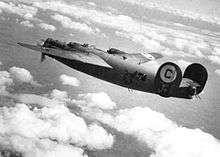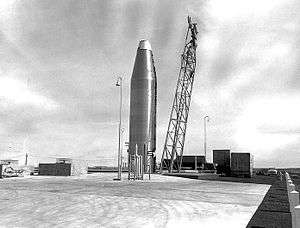566th Strategic Missile Squadron
| 566th Strategic Missile Squadron | |
|---|---|
|
566th Strategic Missile Squadron SM-65E Atlas Missile in fully raised position at launch missile site | |
| Active | 1943-1965 |
| Country |
|
| Branch |
|
| Type | Squadron |
| Role | Intercontinental ballistic missile |
| Garrison/HQ | Francis E. Warren AFB, Wyoming |
| Engagements |
World War II (EAME Theater) |
| Decorations |
Distinguished Unit Citation |
| Insignia | |
| 566th Strategic Missile Squadron emblem |
|

The 566th Strategic Missile Squadron (566 SMS) is an inactive United States Air Force unit. It was last assigned to the 389th Strategic Missile Wing, stationed at F. E. Warren AFB, Wyoming.
On 15 August 1959, the 565th Strategic Missile Squadron (ICBM-Atlas) went on alert as a Strategic Air Command (SAC) Intercontinental ballistic missile (ICBM) squadron, being equipped with the SM-65E Atlas, with a mission of nuclear deterrence.
The squadron was inactivated as part of the phaseout of the Atlas ICBM on 25 March 1965.
History
World War II
Activated as a B-24 Liberator heavy bombardment squadron in December 1942; assigned to II Bomber Command for training. Primarily trained in Texas and Colorado. Received deployment orders for the European Theater of Operations (ETO) in April 1943.
Deployed to England in May 1943, being assigned to the VIII Bomber Command and stationed at RAF Hethel. Upon its arrival at Hethel, almost was sent to Libya, where it began operations on July 9, 1943. The detachment flew missions to Crete, Sicily, Italy, Austria, and Romania. Received a Distinguished Unit Citation for the detachment's participation in the famed low-level attack against oil refineries at Ploesti on August 1, 1943. Returned to England in August and the squadron flew several missions against airfields in France and the Netherlands.
The squadron deployed again temporarily to Tunisia during September and October 1943 with the group supporting Allied operations at Salerno and hit targets in Corsica, Italy, and Austria.
Resumed operations from RAF Hethel in October 1943 the squadron engaged in very long range strategic bombardment operations over Occupied Europe and Nazi Germany. Targets included industrial facilities; oil production facilities and refineries, rail and other transportation centers, enemy military airfields and garrisons. The squadron participated in the intensive air campaign against the German aircraft industry during Big Week, February 20–25, 1944.
Continued attacks on enemy targets until the German Capitulation in May 1944; returning to the United States later that month and reforming at Charleston Army Airfield, South Carolina. Unit personnel were demobilized throughout the summer of 1945. Inactivated on 13 September 1945.
Effective 15 September 1947, the squadron was activated at Rapid City Army Air Base, South Dakota. Having been allotted to the organized reserves, with assignment to Second Air Force, Air Defense Command, it was redesigned as a very heavy bombardment unit on 25 August. In July 1948, the squadron was assigned to the Tenth Air Force, which in December, became a part of the Continental Air Command. The squadron was inactivated on 27 June 1949 due to budget restrictions.
Intercontinental Ballistic Missile Squadron
Reactivated in 1959 as a Strategic Air Command SM-65D Atlas ICBM launch squadron, stationed at Offut AFB, Nebraska and assigned to the 4321st Strategic Wing. Construction delays in 1960 and 1961 led to delays in the construction of the squadron's ICBM silos and becoming operationally ready. On July 1, 1961, SAC redesignated the 566th SMS as the 549th Strategic Missile Squadron. The 566th SMS was immediately reactivated and assigned to the 389th Strategic Missile Wing at FE Warren AFB, Wyoming with SM-65E Atlas missiles, re-designating the 549th SMS.
The squadron was assigned nine missiles, based in a 1 x 9 configuration: nine independent launch sites comprised a missile squadron. The major enhancement in the Atlas E was the new all-inertial system that obviated the need for ground control facilities. Since the missiles were no longer tied to a central guidance control facility, the launchers could be dispersed widely.
The missiles were housed in a "coffin launcher" style complexes. The missile was kept in a horizontal position. In order to launch, a 400-ton overhead door was rolled back after which the "bird" was raised to a vertical position. Once upright, the rocket was fueled with RP-1 and Liquid Oxygen after which it would then be made ready for launch. The Atlas E was equipped with a Mark IV re-entry vehicle developed by General Electric and carried a type W-38 warhead which had a yield of approximately 4 megatons of TNT. It had a range of approximately 6,000 miles. (see below for site details).
Missiles were retired and removed in late 1964 in favor of the more advanced LGM-25C Titan II; the last missile was taken offline on January 4, 1965, and the squadron was inactivated on 25 March. Missile sites were later sold off to private ownership after demilitarization.
Lineage

- Constituted 566th Bombardment Squadron (Heavy) on 19 Dec 1942
- Activated on 24 Dec 1942
- Inactivated on 13 Sep 1945
- Re-designated 566th Bombardment Squadron (Very Heavy) on 25 Aug 1947
- Activated in the reserve on 15 Sep 1947
- Inactivated on 27 Jun 1949
- Re-designated 566th Strategic Missile Squadron on 22 Apr 1959
- Activated on 15 Aug 1959
- Inactivated on 25 March 1965
Assignments
- 389th Bombardment Group, 24 Dec 1942-13 Sep 1945
- Second Air Force, 15 Sep 1947
- Tenth Air Force, 1 Jul 1948-27 Jun 1949
- Second Air Force, 15 Aug 1959
- 4321st Strategic Wing, 1 Oct 1959
- 389th Strategic Missile Wing, 1 Jul 1961-25 March 1965
Stations
|
|
Aircraft and missiles

- B-24 Liberator, 1942-1945
- B-29 Superfortress, 1947-1949
- SM-65E Atlas Missile, 1961-1965
- Operated nine missile sites, one missile at each site (9 total):
- 566-1, 6.5 mi SSE of Chugwater, WY 41°40′07″N 104°46′37″W / 41.66861°N 104.77694°W
- 566-2, 8.8 mi SW of LaGrange, WY 41°33′39″N 104°17′56″W / 41.56083°N 104.29889°W
- 566-3, 2.5 mi N of Pine Bluffs, WY 41°13′05″N 104°03′56″W / 41.21806°N 104.06556°W
- 566-4, 2.2 mi SW of Kimball, NE 41°12′36″N 103°41′09″W / 41.21000°N 103.68583°W
- 566-5, 5.1 mi N of Grover, CO 40°56′44″N 104°12′57″W / 40.94556°N 104.21583°W
- 566-6, 3.2 mi WNW of Briggsdale, CO 40°38′56″N 104°23′04″W / 40.64889°N 104.38444°W
- 566-7, 6.7 mi NNE of Nunn, CO 40°47′17″N 104°43′10″W / 40.78806°N 104.71944°W
- 566-8, 1.9 mi W of Greeley, CO 40°25′46″N 104°51′42″W / 40.42944°N 104.86167°W
- 566-9, 8.8 mi NW of Fort Collins, CO 40°40′43″N 105°12′13″W / 40.67861°N 105.20361°W
See also
References
![]() This article incorporates public domain material from the Air Force Historical Research Agency website http://www.afhra.af.mil/.
This article incorporates public domain material from the Air Force Historical Research Agency website http://www.afhra.af.mil/.
- Maurer, Maurer, ed. (1983) [1961]. Air Force Combat Units of World War II (PDF) (reprint ed.). Washington, DC: Office of Air Force History. ISBN 0-912799-02-1. LCCN 61060979.
- Maurer, Maurer, ed. (1982) [1969]. Combat Squadrons of the Air Force, World War II (PDF) (reprint ed.). Washington, DC: Office of Air Force History. ISBN 0-405-12194-6. LCCN 70605402. OCLC 72556.


